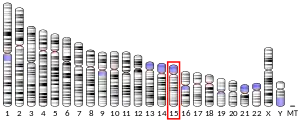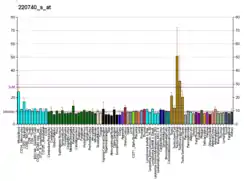Solute carrier family 12 member 6 is a protein that in humans is encoded by the SLC12A6 gene.[5][6][7]
This gene is a member of the K-Cl cotransporter (KCC) family. K-Cl cotransporters are integral membrane proteins that lower intracellular chloride concentrations below the electrochemical equilibrium potential. The proteins encoded by this gene are activated by cell swelling induced by hypotonic conditions. Alternate splicing results in multiple transcript variants encoding different isoforms, the most important ones being KCC3a and KCC3b. Mutations in this gene are associated with agenesis of the corpus callosum with peripheral neuropathy.[7]
See also
References
- 1 2 3 GRCh38: Ensembl release 89: ENSG00000140199 - Ensembl, May 2017
- 1 2 3 GRCm38: Ensembl release 89: ENSMUSG00000027130 - Ensembl, May 2017
- ↑ "Human PubMed Reference:". National Center for Biotechnology Information, U.S. National Library of Medicine.
- ↑ "Mouse PubMed Reference:". National Center for Biotechnology Information, U.S. National Library of Medicine.
- ↑ Hiki K, D'Andrea RJ, Furze J, Crawford J, Woollatt E, Sutherland GR, Vadas MA, Gamble JR (May 1999). "Cloning, characterization, and chromosomal location of a novel human K+-Cl− cotransporter". J Biol Chem. 274 (15): 10661–7. doi:10.1074/jbc.274.15.10661. PMID 10187864.
- ↑ Mount DB, Mercado A, Song L, Xu J, George AL Jr, Delpire E, Gamba G (Jul 1999). "Cloning and characterization of KCC3 and KCC4, new members of the cation-chloride cotransporter gene family". J Biol Chem. 274 (23): 16355–62. doi:10.1074/jbc.274.23.16355. PMID 10347194.
- 1 2 "Entrez Gene: SLC12A6 solute carrier family 12 (potassium/chloride transporters), member 6".
External links
Further reading
- Race JE, Makhlouf FN, Logue PJ, et al. (2000). "Molecular cloning and functional characterization of KCC3, a new K-Cl cotransporter". Am. J. Physiol. 277 (6 Pt 1): C1210–9. doi:10.1152/ajpcell.1999.277.6.C1210. PMID 10600773.
- Casula S, Shmukler BE, Wilhelm S, et al. (2001). "A dominant negative mutant of the KCC1 K-Cl cotransporter: both N- and C-terminal cytoplasmic domains are required for K-Cl cotransport activity". J. Biol. Chem. 276 (45): 41870–8. doi:10.1074/jbc.M107155200. PMID 11551954.
- Howard HC, Mount DB, Rochefort D, et al. (2002). "The K-Cl cotransporter KCC3 is mutant in a severe peripheral neuropathy associated with agenesis of the corpus callosum". Nat. Genet. 32 (3): 384–92. doi:10.1038/ng1002. PMID 12368912. S2CID 23820724.
- Strausberg RL, Feingold EA, Grouse LH, et al. (2003). "Generation and initial analysis of more than 15,000 full-length human and mouse cDNA sequences". Proc. Natl. Acad. Sci. U.S.A. 99 (26): 16899–903. Bibcode:2002PNAS...9916899M. doi:10.1073/pnas.242603899. PMC 139241. PMID 12477932.
- Bräuer M, Frei E, Claes L, et al. (2003). "Influence of K-Cl cotransporter activity on activation of volume-sensitive Cl− channels in human osteoblasts". Am. J. Physiol., Cell Physiol. 285 (1): C22–30. doi:10.1152/ajpcell.00289.2002. PMID 12637262.
- Bergeron MJ, Gagnon E, Wallendorff B, et al. (2003). "Ammonium transport and pH regulation by K+-Cl− cotransporters". Am. J. Physiol. Renal Physiol. 285 (1): F68–78. doi:10.1152/ajprenal.00032.2003. PMID 12657561. S2CID 7129055.
- Shen MR, Lin AC, Hsu YM, et al. (2004). "Insulin-like growth factor 1 stimulates KCl cotransport, which is necessary for invasion and proliferation of cervical cancer and ovarian cancer cells". J. Biol. Chem. 279 (38): 40017–25. doi:10.1074/jbc.M406706200. PMID 15262997.
- Mercado A, Vázquez N, Song L, et al. (2005). "NH2-terminal heterogeneity in the KCC3 K+-Cl− cotransporter". Am. J. Physiol. Renal Physiol. 289 (6): F1246–61. doi:10.1152/ajprenal.00464.2004. PMID 16048901. S2CID 43713884.
- Uyanik G, Elcioglu N, Penzien J, et al. (2006). "Novel truncating and missense mutations of the KCC3 gene associated with Andermann syndrome". Neurology. 66 (7): 1044–8. doi:10.1212/01.wnl.0000204181.31175.8b. PMID 16606917. S2CID 280621.
- Hsu YM, Chou CY, Chen HH, et al. (2007). "IGF-1 upregulates electroneutral K-Cl cotransporter KCC3 and KCC4 which are differentially required for breast cancer cell proliferation and invasiveness". J. Cell. Physiol. 210 (3): 626–36. doi:10.1002/jcp.20859. PMID 17133354. S2CID 21615465.
- Salin-Cantegrel A, Rivière JB, Dupré N, et al. (2007). "Distal truncation of KCC3 in non-French Canadian HMSN/ACC families". Neurology. 69 (13): 1350–5. doi:10.1212/01.wnl.0000291779.35643.15. PMID 17893295. S2CID 22747004.
- Hsu YM, Chen YF, Chou CY, et al. (2007). "KCl cotransporter-3 down-regulates E-cadherin/beta-catenin complex to promote epithelial-mesenchymal transition" (PDF). Cancer Res. 67 (22): 11064–73. doi:10.1158/0008-5472.CAN-07-2443. PMID 18006853.
This article incorporates text from the United States National Library of Medicine, which is in the public domain.




